Ocean Energy: Energy from The Ocean Waves - Part 1
We all know a thing or two about waves, right? We've seen examples like ripples in water, the sound we hear, and also we know that light is partly a wave. In this post we will focus on ocean waves, the energy related to them, and some means of harnessing this energy (converting it into electricity, which has countless applications for us, at present as well as in future).
This is my second post on ocean energy. In the first one, we had a brief introduction to different means by which the ocean stores different forms of energy. Starting from this post, we shall learn about different ways to utilize these different forms of ocean energy.
So what's with the waves?
Well, waves are "theoretically" the most abundant source of energy that we can use. The total amount of ocean wave energy on earth is more than twice the global energy consumption in 2008, again this is only in theory. We simply cannot collect energy from every single wave in the ocean, nor can we harness energy too far away from the shores, since we live on the land, and it could be uneconomical and lossy to transfer energy too far. Nevertheless, it is still a better way of life to gather clean energy from oceans compared to dumping plastic waste in them, or drilling fuel from them which would further pollute the environment when burnt.
Let's begin...
If we were to set up a power plant based on ocean waves, we would want to be assured that the energy in the form of ocean waves is almost always available. For efficiency, we want our power plant always up and running, generating electricity 24 x 7. And to achieve this we need to know where and how the wave energy in ocean comes from. Is it really available 24 x 7?
Simply put, waves in the ocean are created by the wind. We discussed this in our last post. Today we'll see this process a bit more closely.
The moving air molecules in the wind strike the ocean surface as the wind blows over it. In doing so, the air molecules lose their kinetic energy when they collide with the dense water molecules on the ocean surface. The water molecules gain this lost energy, and store it in two ways:
As potential energy: Let's say the ocean was really still before the wind began to blow over it. When the wind blew over it, some of it's water rose higher, didn't it? That's a gain in potential energy.
As kinetic energy: The same potential energy gathered by water rising above the sea level is converted into kinetic energy once it reaches the crest, and starts falling down towards the trough of the wave. Also, this kinetic energy is imparted to nearby water molecules as water molecules collide with each other during their movement, which is how an ocean wave basically "travels" from one place to other.
So how big are these waves? And how long do they last? We really want to make the most out of these waves, and hence we want them to be as energetic (rising higher) as possible. It's clean energy after all, we better get the most out of it. Well, the amplitude and life span of a wave depends on three factors:
1. Wind Speed
The faster the wind blows, the more kinetic energy air molecules have. And hence, more energy is imparted to the water molecules, which results in waves with larger amplitudes. Or simply, the resulting waves are more energetic.
2. Length of time the wind blows
If you've ever observed a ripple (not talking about the crypto, although I do like the way it rises too), you know that water surface is quite efficient at transferring the energy from one point to another. Despite this fact, the waves don't last very long after the wind stops blowing over the ocean. To add more to this, the waves would lose their energy even faster if we are collecting and using that energy, and then we'd have a not so efficient power station.
In this sense, it is really important that we find suitable places where wind blows almost the entire day, almost every day. There are seasonal variations in wind though. Unluckily, India has the low amount of wave energy in it's ocean waters. Why? Let's see...
3. Fetch
The length of the ocean over which the wind blows is called fetch. This length, pus the wind speed together determine what the size of the waves will be. For example, since the fetch is much longer away from land the resulting waves are huge in the parts of ocean which are far away from the land. The image that shows the wave energy potential in different areas of earth shows this very clearly.
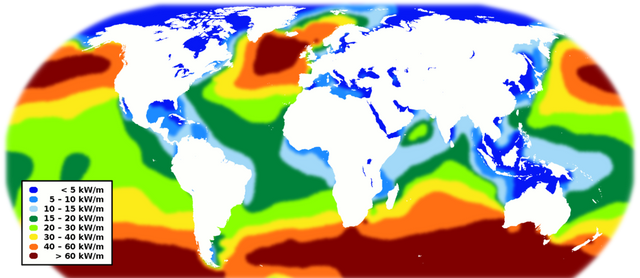
Image Source
Attribution : By Ingvald Straume [CC0], from Wikimedia Commons
Simply put, the faster and wider the wind blows, the more energy the water molecules acquire, thus resulting in bigger waves.
Fetch is also the reason behind the disastrous storm surges that occur near the coast. The Bay of Bengal region is the most vulnerable to this type of natural disaster.
Now let's talk about how we can get the juice from these waves...
The Electricity
By 2012, there were more than 50 devices in various stages of development that could be used in future for harnessing wave energy. By now this number might have grown to about 75, considering our inclination towards clean energy, and hence a cleaner environment.
Most of these devices can be classified according to how they interact with the waves to gain energy from them, the depth of ocean (shallow, intermediate, deep) they require for their operation, and how far from land (shoreline, near shore, offshore) they need to be located to be most efficient.
Due to space and time constraints, we can't talk about the technologies themselves, but we will get the basics and I will dedicate the next post in this series entirely to the wave energy technologies.
Also, for most efficient operation of our devices, they need to move very efficiently. This is achieved either by giving our device a slight upward push every time the wave is rising (resonance). This is easier to imagine with a swing in our parks, it moves farther and higher when it is slightly pushed forward when the swing itself is moving forward. The other way is by holding the movement for a while (latching, which stores some potential energy to be used) and then letting it go. This movement is almost like a spring after it is compressed and released, causing the spring to travel farther than it's original length. This further results in a more efficient energy conversion.
Dancing with the waves:
If you've been on a ship before, you know it moves a bit with the waves. Standing on a floating object is much different than standing on solid ground. The devices that operate in ocean use some basic kinds of such motions like pitching, heaving, surging and swaying.
Pitching causes a tilt in the direction of the wave. This movement is used in triboelectric generators. Don't worry about the terms, triboelectricity is simply electricity generated by friction, as in the charges transferred between a glass rod and silk when rubbed with each other. The gif shows a basic design about how this friction occurs. Wave attenuators use pitching movement as well, we'll talk about them in our next post.
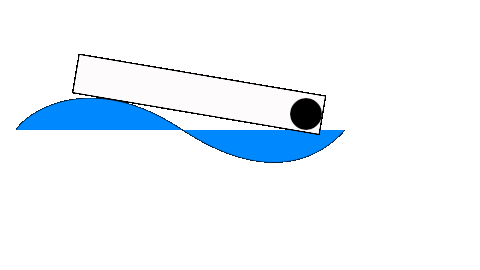
Heaving causes the up and down movement of objects on the ocean surface. This is commonly felt when we are on a stable ship. Point electricity generators use this kind of movement for their operation. The gif below gives a basic idea about how this works. The design shown below is not the only one (or even the proper one, I am new to animation... lol), there are many, but it gives some idea I hope.
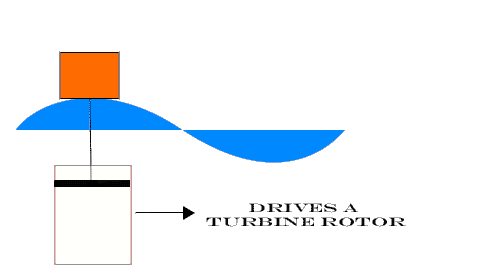
Surging causes to and fro motion in the same direction in which waves are travelling. Swaying causes a sideways rotational movement. these are shown in the images below.
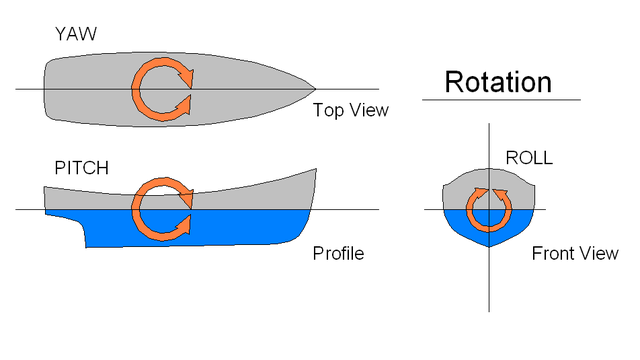
Animations are done using Synfig Studio.
Hope you enjoyed the article...
Take care.
Resources:
1,2,3,4,5,[6](www.alternative-energy-tutorials.com › Wave Energy),7,8.
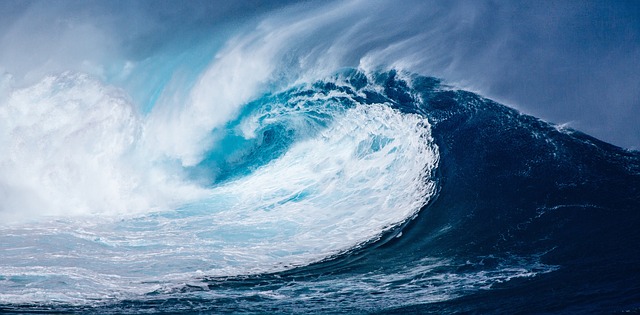
Very readable, and the animations show effort, which I always appreciate.
Isn't the sun though the most plentiful energy source we have?
Sun is undoubtedly the most plentiful energy source we have, BUT... There is a disadvantage - the huge area of land that needs to be covered by solar panels in a power plant. Panels are way more helpful on rooftops than on land that could be used for farming or habitation. And sun isn't available all 24 hours.
Ocean wave and current energy, is a result of wind, which further is caused by temperature difference in the atmosphere... caused by our sun. So ocean energy is essentially indirect solar energy, and we don't require any land in this case. Population is rising, there will be more mouths that need feeding and we will need more shelters as well. Plus wind blows almost all day and night, so waves and currents are available almost all day and night.
Thanks for asking.
And thank you for answering. Good & clear response!
Man, you are awesome. I really love to read your article and its so easy so understand and entertaining at the same time.
Thanks @rifkan
Very nice explanation. Thank you